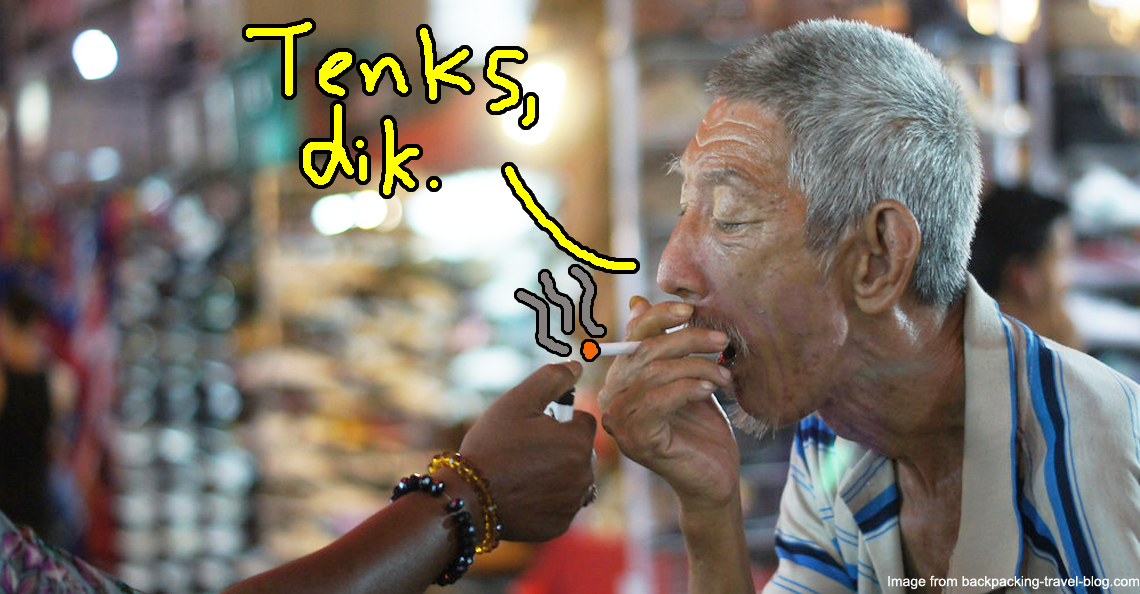Will RM50 cigarettes make people quit? 14 hardcore smokers tell us what they think

- 529Shares
- Facebook494
- Twitter1
- LinkedIn4
- Email7
- WhatsApp23
[The original article was written in BM. You can read it here.]
Back in school, the Tak Nak merokok campaign was the go to example when we were writing karangans about the plight of smoking. Some of us might even have the fond memory of smuggling cigarettes into school and sneaking behind a school block to steal a puff or two, then being caught by the discipline teacher, who probably smokes too…
The gomen has consistently been trying to stem Malaysia’s smoking habit, from airing heartbreaking/ scary TV commercials like this one, to plastering graphic images on cigarette boxes, and raising cigarette prices. But despite their efforts, it has not been remotely close to achieving its objective. As a Health Ministry statistics discovered, the number of cigarettes smoked increased from 18 billion sticks in 1998 to 23.7 billion sticks in 2015.

Back in October 2017, the Malaysian Youth council suggested to the gomen that the price should be raised up to RM50 for a pack of cigarettes to prevent the younger generations from easily acquiring them (what kind of pocket money are kids getting these days). But how well is that idea going to work? We asked 14 smokers about what they think about Malaysia’s smoky situation.
Illegal cigarettes are everywhere, and raising prices will make them more popular

The ease of accessing contraband cigarettes is an open fact among Malaysian smokers. Shaiful (smoker of 7 years) and Farhan (5 years) admits that they would switch to contraband cigarettes if the prices go too high. Syahir (8 years) and Syah (10 years) on the other hand, said only fools and people with too much money buy legal ones, and there’s little difference in quality between the two.
“Even if the contraband cigarettes rise in price, it won’t be as expensive as normal ones. So it’s hard to ask Malaysians to quit smoking unless contraband cigarettes are hard to get.” – Bert, smoker of 8 years
To put things into perspective, a pack of cigarettes costs around RM17, while the illegal ones can cost as low as only RM4. While the National Health and Morbidity Study noted a slight drop in smoking among those below 18 (it went down 0.6% from 2011 to 2015), illegal cigarette consumption reached a record high of 57.1% of the total cigarettes consumed in the country in 2016 (according to The Malaysian Reserve).
But, why should we care about contraband cigarettes? Because a loss of profit for the gomen also means loss of the people’s money, so less BR1M for me and you. According to former Director General of the Economic Planning Unit, one major reason for the prevalence of contraband cigarettes is our loose border control.

Actually, raising the price can be very effective, but other measures have to be enforced too
Did you know that, the world’s most expensive place to buy cigarettes is actually Australia? It cost about 18 USD (RM76) to buy a pack of cigarettes there. And in 2016, Australian Institute of Health and Welfare found that the country’s smoking rate was at an all time low. Over the last 20 years, the number of smokers there decreased by almost 50%. Less than 13% of Australians are daily smokers, and less people are picking up the habit.

By we also raise price mah, why Malaysia numbers never go down? Because more than just raising prices, Australia also takes on public smoking very, very seriously. Smoking is banned in virtually all public places, including public transport stations, restaurants, gomen facilities, clubs, you name it. Smoking isn’t even allowed within 10 meters of children’s play equipment, and it’s even disallowed in cars when someone younger than 16 is in there with you.
Australia was also the first country to implement the plain packaging rule. Logos and promotional text are all not allowed, and the packs even had to use a kind of colour that was purposely chosen to sicken people. The Australia gomen even had to fight tobacco companies for the right for the implementation, and many countries followed in their footsteps after they won the suit. Now, all the package just look like chronic diseases in a box.

But even then, it doesn’t mean Australia is free from smuggling problems. Though their illicit products stands at 14.3% of all tobacco consumed, it still translates to about $1.4 billion (RM4.5 billion) of loss each year for the Australian gomen, based on numbers from 2016. Coming back to raising prices, some of our respondents actually expressed the desire to quit if prices were really raised to RM50 per pack.
“If cigarettes are raised to RM50, I would immediately quit smoking. I can buy 3 chickens, and that’s going to last me for at least 3 weeks.” – Hawa, smoker of 5 years
“Definitely for sure, Rm50 for 20 sticks is just too much,” – Kavin, smoker of 7 years
Others feel that raising the price has to come hand in hand with cracking down on illicit cigarettes, because how can you stop smoking when there are still cheaper options everywhere around you?
“Illicit cigarettes have to be eliminated… then people can quit when they run out of money.” – Syah, smoker of more than 10 years
So there you have it, Malaysian smokers came together and solved the smoking problem. You’re welcome, gomen.
But out of curiosity, what do smokers think is a good way to get people to stop smoking?
We also asked our respondents about how to stop Malaysians from smoking, because who would know more about smoking than smokers themselves right?
1. Take early education more seriously
“Education not just through speeches, but live experimental showing what happens to lungs and how it affects people!” – Kavin, smoker of 7 years
“Put more emphasis on subjects like moral and civics that aren’t really being taken seriously right now.” – Syahir, smoker of 8 years
Kids spend a lot of time in school, which is why the Health Ministry and the Education Ministry have worked together to teach kids about the risks of smoking through a program called IMFree. It was launched in 2016 and by 2021, they aim to involve 1,500 schools across the country. According to the Deputy Health Minister, the smoking trend among 13 to 15 year olds fell from 18.2% in 2009 to 14.8% in 2017.

2. Stricter enforcement of smoking laws
“I heard that the authorities in Melaka are issuing summons to those who smoke in public places such as eateries, shopping mall areas and family areas.” – Faiz, smoker of 12 years
Beginning of May 31st this year, the authorities have begun dishing out fines up to RM250 to those caught smoking in public places across Malaysia. The Department of Health in Melaka issued RM90,830 worth of summons in 2016 alone. Besides that, Melaka also raised the bar to a RM10,000 fine or not more than 2 years jail sentence for those caught smoking in public places.
3. Set up designated smoking areas away from the public
“Make eateries and restaurants smoking free areas. It’s very satisfying to smoke after a meal or when you’re just hanging out with friends.” – Amir, smoker of 7 years
“Maybe to stop secondary smoking and all that. Eventually, smokers might also get lazy because you have to walk to a specific place just to smoke.” – Farhan, smoker of 5 years
While not as strict as what we discussed about in Australia, the Health Ministry included camping sites and playgrounds to the list of non-smoking public places this year. You can take a look at the full list here because some states are slightly different, in case you don’t want to end up being fined.
4. Subsidised treatment for those who are addicted to smoking
“Is smoking a recreational activity? Haha. Because people want to look for the most convenient and cheapest recreation. But turns out, smoking is addictive.” – Azmin, smoker of 10 years

Truth be told, we do have “Klinik Berhenti Merokok” set up in both public and private hospitals and in 145 other agencies. The turn out to these clinics however, are quite low. In 2016, out of the 4,710 smokers that joined, only 1,223 of them managed to quit. In this aspect, perhaps we can take a lesson from Iceland’s proposal for a unique approach of selling cigarettes.
Iceland was considering making cigarettes a prescription product, meaning that you can only buy them in the pharmacy, with a doctor’s letter. This is only after smokers go through various addiction programs or treatments to give up smoking. If they prove that they are unable to quit, they may buy cigarettes under recommendation of the doctor.
Smoking is still a personal choice, but why is the whole world (literally) so against it!?
Although the practice of smoking has been around since thousands of years ago, why do so many gomens insist on making life hard for smokers across the world? #respekmyrights

Because smoking is bad, and it’s killing its precious citizens, and ruining the health quality and productivity of others around them. We’d pull all the statistics for you one by one, but the fact that countries have won the right to package cigarettes like little boxes of medical horrors, with large labels warning of possible death should speak for itself, really.
Still, despite all that, people still choose to light up. Perhaps the reality its as Adly puts it:
“Based on what I’ve seen, smokers will only truly quit when they get some chronic disease or when they see their loved ones die from smoking.” – Adly, smoker of 5 years
As Bert (8 years) says, the decision to quit or not is ultimately on the smoker him/herself, what the gomen can do is simply make it more difficult for smokers to discourage them, and also to facilitate their decision to quit. On the other hand, cigarette companies will continue to attract people with new products to guard their interests.
In the end, maybe the best way to stop the smoking trend, is to lead by example. As smoker that has quit for 5 years told us:
“I think a large part of it is the community. If elders and parents are doing it, its sending a message to the younger generation that the practice is OK.” – Lyds, ex-smoker of 7 years
- 529Shares
- Facebook494
- Twitter1
- LinkedIn4
- Email7
- WhatsApp23
